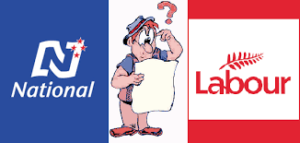This week there was a fascinating article about how Labour and National are essentially the same. Tweedledum and Tweedledumber.
The article writes:

How did we end up with two main parties that are basically pretending to do things differently? One economist, Harold Hotelling, wrote a paper all the way back in 1929 that helps explain why this happens. Luckily for us, “Hotelling’s law” (not to be confused with his “rule“, or his “lemma“) is best explained with ice cream.
Then they gave as an example of people on a beach:
It’s the launch day for two new ice cream stands, both set up literally on the beach (we know it’s a bit weird two ice cream stands chose the same launch date, just bear with us). The ice cream stands are offering the same ice creams at the same prices (yes, we know, also weird), so since there’s no difference, you just go for the closer one. The two stands have positioned themselves so one is a quarter of the way along the beach, and the other is three-quarters along the beach. All the little clusters of people spread out across the beach don’t have too far to go to get to their nearest ice cream, and each stand picks up half the custom of the beach.
You had such a great day at the beach eating ice cream, you go back the next day. Once again happy people are spread out across the length of the beach, enjoying the sun. The ice cream sellers are there again, but something has changed. The one on the left side of the beach has shuffled in a bit to the centre. Very savvy of them – they now pick up more custom, because by moving towards the middle, they’re still closest to those on the left, but also get closer to more people on the right.
By lunchtime, the one on the right has realised it’s missing out and there’s a simple solution – it relocates towards the middle itself, reclaiming its customers.
Basically, this process repeats until the two stands find themselves next to each other in the middle, with the one on the left picking up all beach-goers to the left and the one on the right picking up those on the right. It’s a shame, really, because they both get the same share of the beach as on the first day, but now some people have to travel the entire half length of the beach to get their ice cream.
They conclude with this paragraph which summarises why we need parties around the edge, like the Greens, TOP and ACT which all promote policies which are, to continue the beach analogy, away from the Centre. All of these minor parties’ policies are an essential element of the political dialogue, and which will eventually become a future Government’s policy. Remember that in its early existence the Labour Party was where the Greens or TOP are today. Through persistent lobbying and courage our forebears in politics changed the political landscape. We need to honour those who were our political tupuna. We need to honour those promoting new ideas, both Left and Right, whatever that means these days:
Obviously, we can’t completely boil down an election to ice cream selling. There’s a lot more going on. We have several parties to choose from, and a party cannot simply “position” itself to attract the most votes – it needs to be trustworthy, accountable to members, and actually want the policy. There are also many things affecting voters aside from policy, like leadership personality, individual MPs, or just voting the way your friends vote. But Hotelling’s law has certainly stood the test of time, and continues to explain how the two biggest parties tend to meet somewhere in the middle.
Here’s the article https://thespinoff.co.nz/society/nzier/04-09-2020/why-are-labour-and-national-policies-basically-the-same/
Leave a Reply